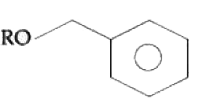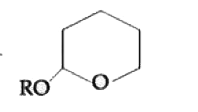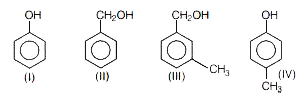Which of the following derivatives of alcohols is unstable in an aqueous base ?



RO−Cme3
To determine which derivative of alcohol is unstable in an aqueous base, we need to analyze the behavior of various alcohol derivatives when exposed to hydroxide ions (OH⁻).
1. Identify Alcohol Derivatives:
- Common derivatives of alcohols include alkyl halides, esters, ethers, and phenols. We need to consider how each of these reacts in the presence of an aqueous base.
2. Understand the Role of Hydroxide Ion (OH⁻):
- Hydroxide ions act as nucleophiles and can attack electrophilic centers in organic molecules. This can lead to the cleavage of certain bonds, which may result in the formation of unstable intermediates.
3. Analyze Each Derivative:
- Alkyl Halides: Generally stable in aqueous base but can undergo nucleophilic substitution.
- Esters: Can react with hydroxide ions to form alcohols and carboxylate ions, but are relatively stable.
- Ethers: Generally stable and do not react with hydroxide ions under normal conditions.
- Phenols: Can react with bases but are also stable.
4. Focus on Unstable Derivatives:
- Among these, we need to identify which derivative can lead to the formation of an unstable intermediate.
5. Identify the Unstable Derivative:
- In the case of certain derivatives, such as certain esters or specific alcohol derivatives, the reaction with hydroxide can lead to the formation of unstable intermediates or products.
- For example, if an alcohol derivative can lead to the elimination of a leaving group (like water or an alcohol), it can create an unstable carbocation or other reactive species.
6. Conclusion:
- Given the analysis, the derivative of alcohol that is unstable in an aqueous base is typically one that can lead to the formation of a carbocation or a similar unstable intermediate upon reaction with hydroxide ions. In this case, the answer is the second derivative mentioned in the context of the question.
Final Answer:
The unstable derivative of alcohol in an aqueous base is the second derivative mentioned in the question.
- Common derivatives of alcohols include alkyl halides, esters, ethers, and phenols. We need to consider how each of these reacts in the presence of an aqueous base.
- Hydroxide ions act as nucleophiles and can attack electrophilic centers in organic molecules. This can lead to the cleavage of certain bonds, which may result in the formation of unstable intermediates.
- Alkyl Halides: Generally stable in aqueous base but can undergo nucleophilic substitution.
- Esters: Can react with hydroxide ions to form alcohols and carboxylate ions, but are relatively stable.
- Ethers: Generally stable and do not react with hydroxide ions under normal conditions.
- Phenols: Can react with bases but are also stable.
- Among these, we need to identify which derivative can lead to the formation of an unstable intermediate.
- In the case of certain derivatives, such as certain esters or specific alcohol derivatives, the reaction with hydroxide can lead to the formation of unstable intermediates or products.
- For example, if an alcohol derivative can lead to the elimination of a leaving group (like water or an alcohol), it can create an unstable carbocation or other reactive species.
- Given the analysis, the derivative of alcohol that is unstable in an aqueous base is typically one that can lead to the formation of a carbocation or a similar unstable intermediate upon reaction with hydroxide ions. In this case, the answer is the second derivative mentioned in the context of the question.
The unstable derivative of alcohol in an aqueous base is the second derivative mentioned in the question.
Topper's Solved these Questions
Similar Questions
Knowledge Check
Which of the following is/are aromatic alcohol?
 AI,II,III,IVBII and IIICI and IVDOnly I
AI,II,III,IVBII and IIICI and IVDOnly IWhich of the following is a trihydric alcohol ?
An- propyt alcoholBGlycerolCGlycolDGlycineWhich of the following in unstable
AC6H5−N2BrBC6H5−N2ICCH3−N2ClDC6H5−N2Cl
